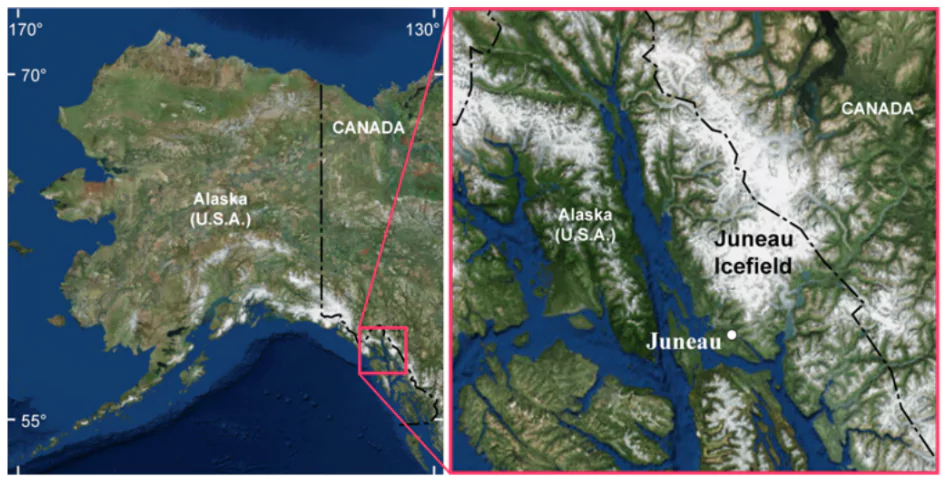A new study suggests that the Juneau Icefield in Alaska could reach an irreversible tipping point sooner than predicted, with its glaciers rapidly receding since 2005.
- The Icefield: The Plateau icefield spans the United States’ Alaska and Canada’s British Columbia and comprises 1,050 glaciers in 2019, covering an area of 3,816.3 square kilometers.
The Study
- Published In: The study was published in the journal, Nature Communications.
- Aim: To determine the rates of icefield-wide shrinkage and thinning to quantify glacier change from the Little Ice Age period (a period of widespread cooling that lasted from 1303 to 1850) to recent times till 2020.
- Scope: To extend the scope of study and examine even longer-term records of icefield change, especially through previous periods of rapid climate change, such as during the last glacial-interglacial transition 19,000 to 11,000 years ago.
Enroll now for UPSC Online Course
Key Findings of the study

- Icefield extent: The reconstructed Little Ice Age revealed that the icefield covered 5,414.95 square kilometres of land, about 30 per cent larger than in 2019.
- Disappearing glaciers: Between 1770 and 2019, 108 glaciers disappeared, and 100 per cent of the glaciers mapped in 2019 had receded compared to their Little Ice Age positions.
- Shrinkage rate: The study found that glacier shrinkage from 2015 to 2019 was five times faster than between 1948 and 1979.
- Glacier volume loss:
- 1770 to 2013: Glacier volume loss was 0.4 cubic kilometres per year.
- 1948 –1979: Glacier volume loss increased to 1.0 cubic kilometres per year
- 1979 – 2000: Glacier volume loss rose to 3.7 cubic kilometres per year
- 2000 to 2010: Glacier volume loss rate witnessed a slight decrease to 3.1 cubic kilometres per year
- 2010 to 2020: Glacier volume loss again increased two times to 5.9 cubic kilometres per year
- Temperatures rise: The temperature in the Alaskan region remained relatively stable from 1990 to 2005, as did icefield thinning and area loss. However, from 2010 to 2020, the region experienced another temperature rise which rose by 1.39°C at Juneau Airport from 1941 to 2020.
- Reason: The temperature rise is due to a shift to predominantly positive values in the Pacific Decadal Oscillation (PDO) from 1976 bringing increased precipitation and warmer temperatures to Alaska and Juneau.
- Pacific Decadal Oscillation (PDO): It is a long-term ocean fluctuation in the Pacific Ocean, which alternates between warm and cool phases approximately every 20 to 30 years.
- Contribution in global Sea level rise: With around 25 per cent of global glacier ice loss coming from Alaskan glaciers, The large icefields here contain enough glacial ice to raise global sea levels by 46.4 millimetres if melted.
- Ice loss: The Alaskan glaciers have lost about 66.7 billion tonnes of ice each year and at this rate, all Alaskan ice could disappear in about 250 years.
Reasons
- Plateau Icefields: Alaskan icefields are particularly vulnerable to increased melting due to its predominantly flat, plateau landscape of its icefields. Ice loss happens across the whole surface affecting a much greater area as the climate warms.
- Rising Equilibrium Line Altitude: One significant factor in glacier volume loss is the rising Equilibrium Line Altitude. The melt is now occurring on the plateau itself, the snowline is on the plateau itself in particularly warm summers ( The flat plateau area was previously above the ELA, with snow remaining year-round)
- Because the plateau is very flat, a small rise in the ELA exposes a much greater area to melt, accelerating icefield mass loss.
- Equilibrium Line Altitude is the zone on a glacier where snow and ice accumulation balance out with loss over a year. As summers lengthen and winters shorten, and temperatures rise, the height at which snow remains all year round is increasing.
Check Out UPSC CSE Books From PW Store
Alaska’s Juneau Icefield
- Location: Juneau Icefield spanning 1500-square-mile is the fifth largest icefield in North America and is located just north of Juneau, Alaska, continuing north through the border with British Columbia.
- Much of the icefield is contained within the Tongass National Forest
- Glaciers: The icefield is the birthing ground of 38 major glaciers, including Juneau’s Mendenhall Glacier and Taku Glacier.
- Training for Moon: NASA has chosen the icefield as one of the places on Earth that “captured the emotional sensations that one might encounter while walking on the moon.”
- Notable peaks: Major peaks on the Juneau Icefield are Devils Paw, Nelles Peak, Emperor Peak
- The Juneau Icefield Research Program: Since 1948, the Juneau Icefield Research Program has monitored glaciers of the Juneau Icefield.
- On the west side of the icefield, from 1946-2009, the terminus of the Mendenhall Glacier has retreated over 700 metres.
|
![]() 4 Jul 2024
4 Jul 2024

